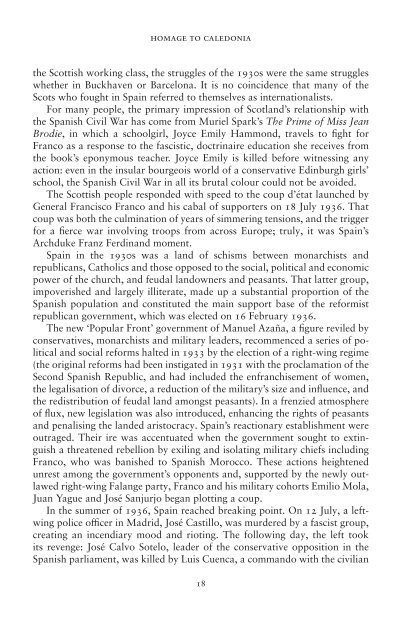Homage to Caledonia by Daniel Gray sampler
The Spanish civil war was a call to arms for 2,300 British volunteers, of which over 500 were from Scotland. The first book of its kind, Homage to Caledonia examines Scotland's role in the conflict, detailing exactly why Scottish involvement was so profound. The book moves chronologically through events and places, firstly surveying the landscape in contemporary Scotland before describing volunteers' journeys to Spain, and then tracing their every involvement from arrival to homecoming (or not). There is also an account of the non-combative role, from fundraising for Spain and medical aid, to political manoeuvrings within the volatile Scottish left. Using a wealth of previously-unpublished letters sent back from the front as well as other archival items, Daniel Gray is able to tell little known stories of courage in conflict, and to call into question accepted versions of events such as the 'murder' of Bob Smillie, or the heroism of 'The Scots Scarlet Pimpernel'. Homage to Caledonia offers a very human take on events in Spain: for every tale of abject distress in a time of war, there is a tale of a Scottish volunteer urinating in his general's boots, knocking back a dram with Errol Flynn or appalling Spanish comrades with his pipe playing. For the first time, read the fascinating story of Caledonia's role in this seminal conflict.
The Spanish civil war was a call to arms for 2,300 British volunteers, of which over 500 were from Scotland. The first book of its kind, Homage to Caledonia examines Scotland's role in the conflict, detailing exactly why Scottish involvement was so profound. The book moves chronologically through events and places, firstly surveying the landscape in contemporary Scotland before describing volunteers' journeys to Spain, and then tracing their every involvement from arrival to homecoming (or not). There is also an account of the non-combative role, from fundraising for Spain and medical aid, to political manoeuvrings within the volatile Scottish left. Using a wealth of previously-unpublished letters sent back from the front as well as other archival items, Daniel Gray is able to tell little known stories of courage in conflict, and to call into question accepted versions of events such as the 'murder' of Bob Smillie, or the heroism of 'The Scots Scarlet Pimpernel'. Homage to Caledonia offers a very human take on events in Spain: for every tale of abject distress in a time of war, there is a tale of a Scottish volunteer urinating in his general's boots, knocking back a dram with Errol Flynn or appalling Spanish comrades with his pipe playing. For the first time, read the fascinating story of Caledonia's role in this seminal conflict.
Create successful ePaper yourself
Turn your PDF publications into a flip-book with our unique Google optimized e-Paper software.
<strong>Homage</strong> <strong>to</strong> <strong>Caledonia</strong><br />
the Scottish working class, the struggles of the 1930s were the same struggles<br />
whether in Buckhaven or Barcelona. It is no coincidence that many of the<br />
Scots who fought in Spain referred <strong>to</strong> themselves as internationalists.<br />
For many people, the primary impression of Scotland’s relationship with<br />
the Spanish Civil War has come from Muriel Spark’s The Prime of Miss Jean<br />
Brodie, in which a schoolgirl, Joyce Emily Hammond, travels <strong>to</strong> fight for<br />
Franco as a response <strong>to</strong> the fascistic, doctrinaire education she receives from<br />
the book’s eponymous teacher. Joyce Emily is killed before witnessing any<br />
action: even in the insular bourgeois world of a conservative Edinburgh girls’<br />
school, the Spanish Civil War in all its brutal colour could not be avoided.<br />
The Scottish people responded with speed <strong>to</strong> the coup d’état launched <strong>by</strong><br />
General Francisco Franco and his cabal of supporters on 18 July 1936. That<br />
coup was both the culmination of years of simmering tensions, and the trigger<br />
for a fierce war involving troops from across Europe; truly, it was Spain’s<br />
Archduke Franz Ferdinand moment.<br />
Spain in the 1930s was a land of schisms between monarchists and<br />
republicans, Catholics and those opposed <strong>to</strong> the social, political and economic<br />
power of the church, and feudal landowners and peasants. That latter group,<br />
impoverished and largely illiterate, made up a substantial proportion of the<br />
Spanish population and constituted the main support base of the reformist<br />
republican government, which was elected on 16 February 1936.<br />
The new ‘Popular Front’ government of Manuel Azaña, a figure reviled <strong>by</strong><br />
conservatives, monarchists and military leaders, recommenced a series of political<br />
and social reforms halted in 1933 <strong>by</strong> the election of a right-wing regime<br />
(the original reforms had been instigated in 1931 with the proclamation of the<br />
Second Spanish Republic, and had included the enfranchisement of women,<br />
the legalisation of divorce, a reduction of the military’s size and influence, and<br />
the redistribution of feudal land amongst peasants). In a frenzied atmosphere<br />
of flux, new legislation was also introduced, enhancing the rights of peasants<br />
and penalising the landed aris<strong>to</strong>cracy. Spain’s reactionary establishment were<br />
outraged. Their ire was accentuated when the government sought <strong>to</strong> extinguish<br />
a threatened rebellion <strong>by</strong> exiling and isolating military chiefs including<br />
Franco, who was banished <strong>to</strong> Spanish Morocco. These actions heightened<br />
unrest among the government’s opponents and, supported <strong>by</strong> the newly outlawed<br />
right-wing Falange party, Franco and his military cohorts Emilio Mola,<br />
Juan Yague and José Sanjurjo began plotting a coup.<br />
In the summer of 1936, Spain reached breaking point. On 12 July, a leftwing<br />
police officer in Madrid, José Castillo, was murdered <strong>by</strong> a fascist group,<br />
creating an incendiary mood and rioting. The following day, the left <strong>to</strong>ok<br />
its revenge: José Calvo Sotelo, leader of the conservative opposition in the<br />
Spanish parliament, was killed <strong>by</strong> Luis Cuenca, a commando with the civilian<br />
18


















